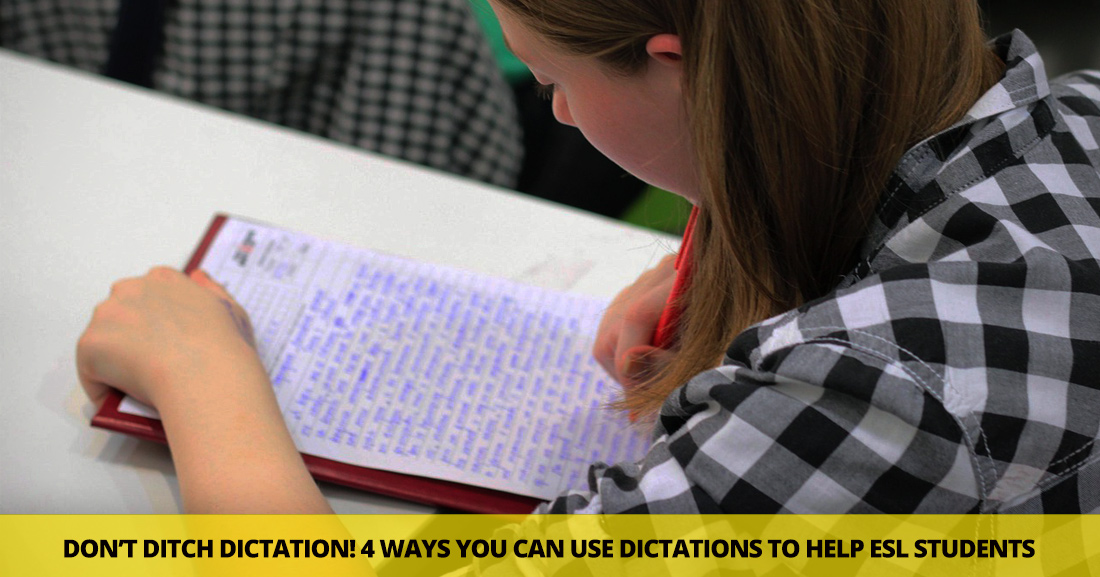Donít Ditch Dictation: 4 Fabulous Ways You Can Use Dictation to Help ESL Students


Once you organize listening exercises, it is beneficial to be able to reshape exercises for all levels. Try out these three listening activities adaptable for any level and hear loud and clear how much they will improve overall listening skills.

Dictation is one of the most adaptable and valid listening exercises that can be utilized at every level. One exceptional value of dictation is that it can be done spontaneously or with great forethought. If you find yourself with a spare ten minutes in class, one tool you can employ is to offer a quick dictation. In addition, if you have a particularly difficult grammar point or one that users really need reiterated, creating a substantial dictation exercise can really drive the point home. Dictation has so many different applications that you can continually use it without it becoming stale.
An example of utilizing dictation for beginner students is for work on numbers. You could read out numbers between one and a million, and have students write out the correct number, or if you really want to challenge them ask them to write out the number with words. Be sure to write down the numbers as you speak them so that you keep track of what numbers the students have been given. You can also involve students by asking them to take turns giving the class a number. To make correction of the dictation interactive, you could do it in rounds, offer prizes for the three best scores, or ask students to take turns writing their answers on the board. You could apply this same practice using phone numbers, addresses, or time.
Another example for more challenging dictation for higher levels is to focus on a specific grammar point. Try reading out a short script or role play. Then give them a task such as writing down all the present perfect verb usage they hear, or noting down any idiomatic phrase as they heard it. These tasks can then lead to discussions of the grammar, of the topic or of usage in general. Whatever task you give them, there should always be time to debrief about how they felt during the exercise, and answer any questions. Think about using dictation for comprehension checks, listening for specific attributes, or as a jumping off point for discussion. You'll find that whether you yourself perform the dictation or whether you use recordings from books or the internet, students will become accustomed to increasingly challenging and varied dictation exercises.
The activity titled Running Stories combines writing, reading, speaking, and listening for a tremendous whole language experience. Here's how it works. Divide the class into two teams and then split the teams in half. One half of each team stays seated and the other half stands at the board. It works best if each team is an equal distance from their seats to the board. Each team is given an envelope with a cut-up excerpt. You can use a piece of a reading, a dialogue, or a conversation. The seated-half teams must quickly assemble the jumbled up reading into what they believe is the cohesive story. Give them a certain amount of time to do this—maybe a minute or two. Then the seated students stand in line at their desks each with a slip of paper from the reading, in the order that they desire to be. This is where it gets crazy and loud. The students at the board should each have a marker and each student takes a turn writing a line on the board. The student with the first slip of paper must clearly shout what it says so the student at the board—a fair distance apart—can write down the line word for word. You can establish as many rules as you like, but the fun part is not letting them linger on any one line for very long. Use a timer or buzzer to designate when the next student is up. This activity breaks the monotony of routine, allows the students to be loud, and hones listening and speaking skills in an organic fashion. Try it with beginners or take it to the next level with your advanced students.
Spoken memory games are a treasure of listening and speaking diversion for every ESL level. You can tailor memory games to grammar, to vocabulary, or to a specific theme or topic. One of the most popular of these is, I'm going to grandma's house and I'm going to bring... Apples, Bingo, Carrots, Dragons, etc. Each student has to name an object, food, or whatever you designate for their letter and they have to repeat each statement that was spoken before them. It's a classic as an ice-breaker or spontaneous exercise. Another adaptation is to use adjectives or verbs. For example, I am going to the beach and I am going to Act, Bake, Canoe, etc. For adjectives the first day name game works really well. I am Joyful Juan, He is Silly Steve, she is Pretty Petra, etc. There's no end to the challenges you can create with memory games and they are the perfect cure to a sleepy class or boring topic!
Students will practice natural listening skills and these activities will also inspire competition, lively discussion, and loud and clear vocalizations.